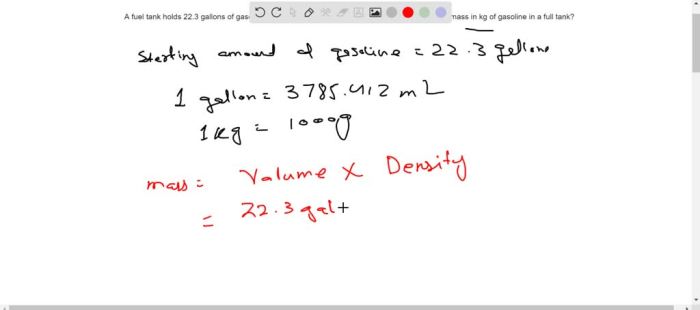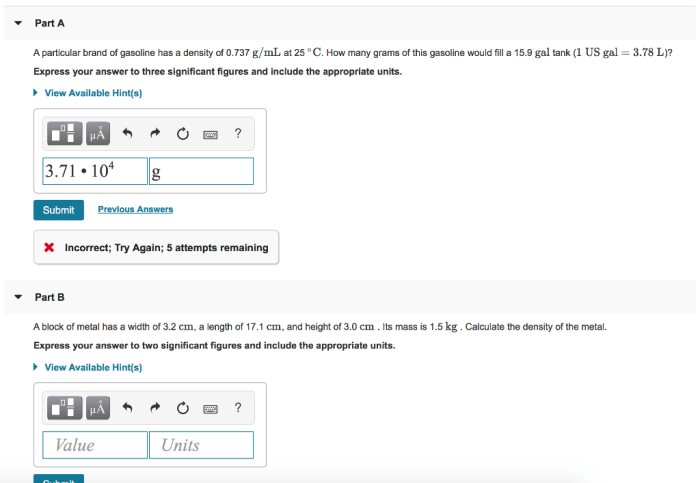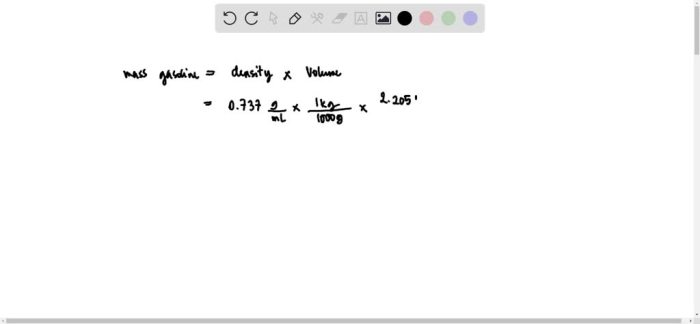A particular brand of gasoline has a density of 0.737 – In the realm of automotive fuels, gasoline stands as a ubiquitous presence, powering countless vehicles across the globe. Among the diverse brands and formulations available, one particular gasoline boasts a distinct density of 0.737, setting it apart from its counterparts.
This article delves into the intriguing world of this gasoline, exploring its physical properties, composition, and practical implications.
Gasoline’s density plays a pivotal role in determining its flow and combustion characteristics, directly influencing engine performance and fuel efficiency. Understanding the nuances of density variations is essential for optimizing fuel utilization and minimizing environmental impact.
Physical Properties of Gasoline

Gasoline, a highly flammable liquid, is characterized by its unique physical properties, including density, which plays a crucial role in understanding its behavior and performance.
Significance of Density in Gasoline Properties
Density, measured in kilograms per liter (kg/L), is a critical indicator of gasoline’s mass and volume relationship. It influences various properties, such as flowability, combustion efficiency, and compatibility with different engine types.
Comparative Analysis of Gasoline Density with Other Fuels
Compared to other fuels, gasoline typically has a lower density. For instance, diesel fuel has a higher density, ranging from 0.83 to 0.89 kg/L, while ethanol has a lower density, around 0.79 kg/L.
Effects of Density on Gasoline’s Flow and Combustion Characteristics
Gasoline’s density directly affects its flowability and combustion characteristics. Lower-density gasoline flows more easily through fuel systems, facilitating efficient fuel delivery to the engine. Moreover, denser gasoline tends to burn more slowly, resulting in reduced engine knocking and improved fuel economy.
Composition and Additives
Gasoline is a complex mixture of hydrocarbons, with its composition and density influenced by various factors, including refining processes and additives.
Major Components of Gasoline and Their Impact on Density
- Paraffins: Straight-chain hydrocarbons that increase gasoline’s density.
- Olefins: Unsaturated hydrocarbons that reduce gasoline’s density.
- Aromatics: Cyclic hydrocarbons that have a moderate impact on density.
Role of Additives in Modifying Gasoline Density and Performance
Additives are substances added to gasoline to enhance its performance and stability. Ethanol, a common additive, reduces gasoline’s density while improving octane rating and reducing emissions.
Influence of Density Variations on Gasoline’s Compatibility with Different Engine Types
Density variations in gasoline can affect its compatibility with different engine types. Higher-density gasoline may require modifications to fuel injection systems to ensure optimal fuel delivery and combustion.
Measurement and Standardization

Accurate measurement and standardization of gasoline density are essential for quality control and performance optimization.
Methods Used to Measure Gasoline Density
- Hydrometers: Instruments that measure the specific gravity of liquids, providing an indirect measure of density.
- Density meters: Electronic devices that directly measure the density of liquids using various principles, such as vibration or buoyancy.
Importance of Standardized Density Specifications for Quality Control
Standardized density specifications, such as those set by ASTM International, ensure consistent fuel quality and performance. They help prevent variations that could compromise engine efficiency and emissions.
Impact of Temperature and Pressure on Gasoline Density Measurements
Temperature and pressure affect gasoline’s density. As temperature increases, density decreases, while increased pressure leads to higher density. These factors must be considered during density measurements to ensure accurate results.
Applications and Implications

Gasoline density has practical applications and implications in various areas.
Examples of How Gasoline Density is Used in Various Applications, A particular brand of gasoline has a density of 0.737
- Fuel economy calculations: Density is used to determine the mass of fuel consumed, which is essential for calculating fuel economy.
- Fuel blending: Refineries adjust gasoline density by blending different components to meet specific performance requirements.
- Taxation: In some jurisdictions, gasoline is taxed based on its density, which influences the final price paid by consumers.
Implications of Density Variations for Fuel Efficiency, Engine Performance, and Emissions
Variations in gasoline density can impact fuel efficiency, engine performance, and emissions. Higher-density gasoline may result in reduced fuel economy but improved engine performance due to slower combustion. Conversely, lower-density gasoline may improve fuel economy but could lead to engine knocking if not properly tuned.
Table Comparing the Density of Different Gasoline Grades and Their Corresponding Octane Ratings
| Gasoline Grade | Density (kg/L) | Octane Rating |
|---|---|---|
| Regular | 0.740-0.755 | 87-91 |
| Mid-grade | 0.735-0.745 | 89-93 |
| Premium | 0.725-0.735 | 91-98 |
Query Resolution: A Particular Brand Of Gasoline Has A Density Of 0.737
What factors influence gasoline density?
Gasoline density is primarily influenced by its composition, including the presence of hydrocarbons, additives, and impurities.
How does density affect gasoline’s combustion characteristics?
Denser gasoline tends to burn more slowly and produce higher octane ratings, resulting in smoother engine operation and reduced knocking.
What are the implications of density variations for fuel efficiency?
Higher density gasoline generally leads to improved fuel efficiency due to its increased energy content per unit volume.